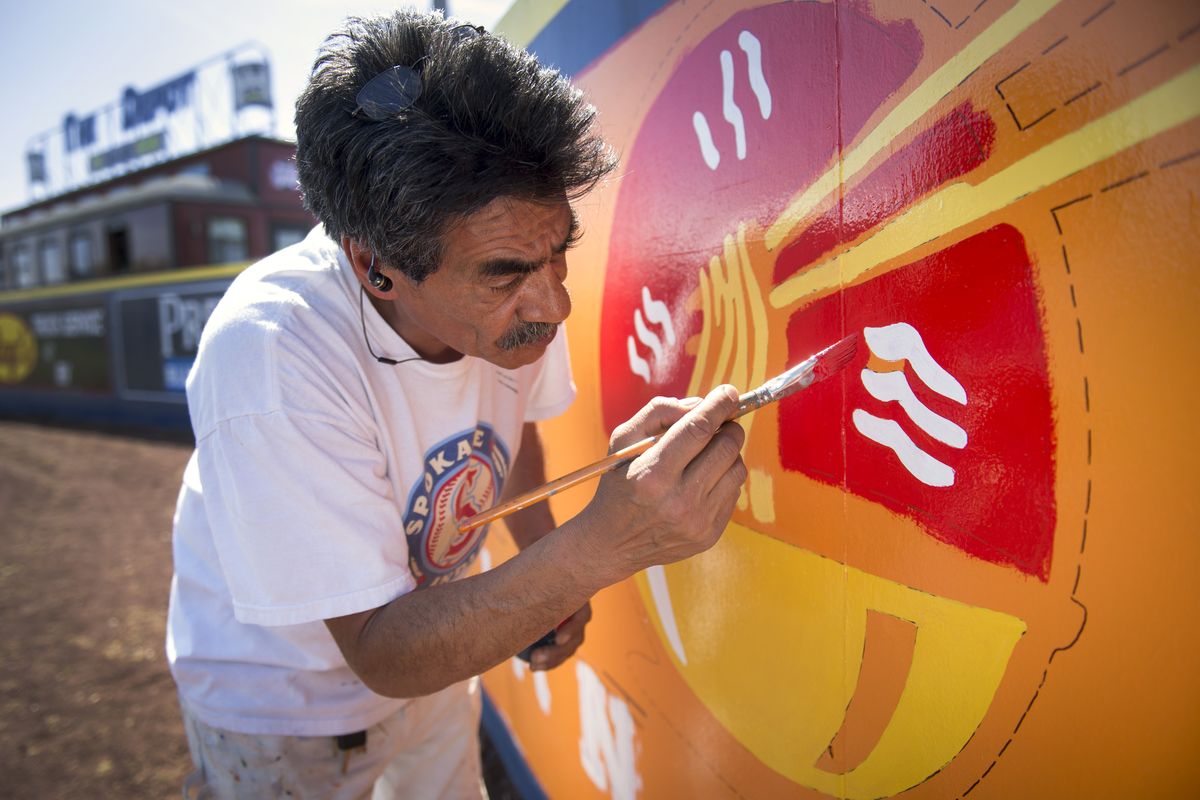For 25 seasons, Ruben Marcilla has painted signs at Avista Stadium – now a fading art in baseball

Ruben Marcilla started painting the signs on Avista Stadium’s outfield fence when the plywood was new, marking off sections that would become insurance and grocery ads so big and bold the farthest-back fan could see them.
From his vantage points along the outfield wall, Marcilla has watched interns and grounds crews come and go and the Spokane Indians’ 1958 stadium undergo modernization. But the sign painter still uses brushes older than the athletes who’ll pound the sod after he’s packed them up. He still shows up every spring to do a job that, in many ballparks and many other places, has been relegated to the tools of mass production.
This season marks Marcilla’s 25th as a sign painter at the stadium. He’s suited for the work.
“I’m an analog man in a digital world,” Marcilla said.
But he has a lot of memory.
Scraping off the layers he might have applied decades ago is like scraping through layers of history.
“And it’ll give me a pause,” he said, “while I try to remember.”
A few weeks before the season’s first pitch, Marcilla, 57, stood in the sun, his paint cans and brushes in the back of his 1992 Subaru Loyale wagon, tailgate open and backed up to an orange Noodle Express sign in progress.
The specifics of his job – performed over roughly 10 weeks starting in mid-April – depend on the year and the advertisers. He touches up some signs and paints others from scratch, stripping the paint for new advertisers or new logos.
“Supercuts has been there pretty much forever, back to when their logo was blue and white, remember?” Marcilla said.
Next year, these will be big pieces falling off, he said, picking at a flake of paint on Ray’s Truck Service & RV.
The outfield-fence signs are promoted to potential advertisers as full-color and hand-painted, viewed by “every fan in the ballpark” and, maybe, on TV or in the newspaper as the backdrop to action.
“They’re kind of our marquee piece of inventory,” said Dustin Toms, the stadium’s director of public relations.
Born in Argentina, Marcilla graduated from the High School of Art and Design, a career and technical education school in New York City, in 1975.
“They were teaching us stuff that doesn’t even exist anymore,” he said. He could do paste-up at a newspaper. He could run one of those two-armed compasses with the point on one arm and the pencil on the other.
He took commercial art classes. And after graduating, he started working at Liberty Signs in New York City, sweeping the floors.
Liberty Signs claimed to employ the best gold-leaf guy in Manhattan, who was bald and 80, or at least seemed to be 80. The gold-leaf guy needed Marcilla’s mane of ’70s hair, Marcilla said, to create a static charge on his gilding brush.
Everything else was done by hand at the sign shop, Marcilla said.
The old-timers would tell him, Oh, you kids got it easy. We used to have to mix our own paint. They bought pigment and mixed it with linseed oil and turpentine. “Isn’t that crazy?” Marcilla said.
He’s worked painting billboards and houses. He paints the logos in the ice for the Spokane Chiefs at the Spokane Arena. He’s painted movie sets.
He started painting the signs at the stadium in 1990, when “this place was ready for the wrecking ball,” he said.
Marcilla said he wishes he’d taken photos each year from the same spot so he could watch them in time-lapse.
Spokane resident Bobby Brett and his brother, baseball Hall of Famer George Brett, bought the stadium in 1985 and – working over the years in alliance with the county and state – started making improvements. Along with infrastructural fixes, they added a Diamond Club, skyboxes, a picnic area.
As Marcilla talked, machinery rumbled as workers turned a dirt lot west of the stadium into a paved one that’ll be ready for the June 13 opener.
When Marcilla’s children, now 26, 28 and 30, were kids, he’d bring them and their bicycles to play while he worked. They rode the empty concourse and up the tunnels inside the locked gates. They checked in periodically, yelling from various points in the stadium: “Hi, Dad!”
Marcilla also paints the skyboxes, but other signs throughout the stadium – directional signs, section markers, recycling signs – are digitally produced.
Marcilla acknowledged improvements over the years in digitally and printer-produced signs. Hand-painted signs are still better, he said, brushing red on the circle in the middle of the Noodle Express sign.
The colors are richer and brighter and last longer, he said.
“I’m not denigrating people who work in vinyl,” Marcilla said, “but any pimply kid with a computer can do it, you know what I’m saying? This is a craft, this is an art.”
Otto Klein, the Indians’ senior vice president, said the organization values the tradition represented by Marcilla’s work and the security of knowing the outfield advertising won’t come apart during a game.
Hand-painted signs do have a different look, Klein said. But “maybe there’s not a big difference. Maybe it’s more about Ruben.”
There’s no succession plan in the case of his retirement, Klein said.
But the painter has no particular plans to stop working. If he retires, it’ll probably be first from painting houses, which is harder physically.
“I figure when I die, then they’ll start doing this digitally, you know what I mean?” Marcilla said. “But as long as I’m around and I’m available, I will continue to hand-paint these signs.”